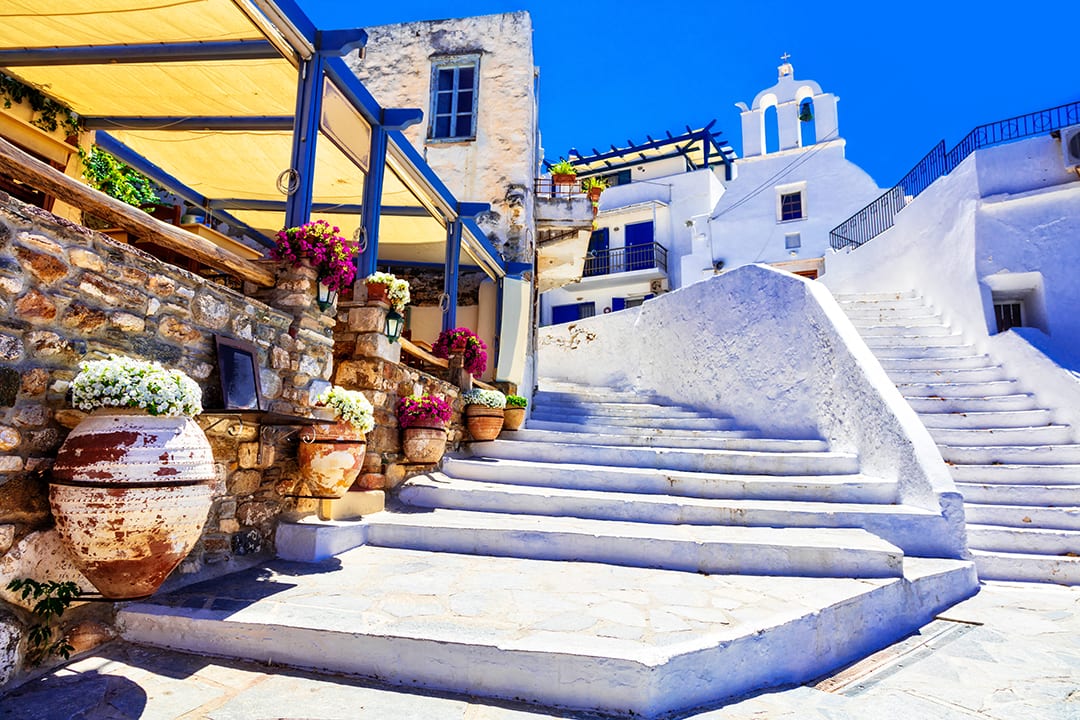
All you need to know about Naxos island!
In the heart of the Aegean Sea lies the largest and greenest island of the Cyclades, Naxos. This lovely island has managed to remain off the radar of mainstream tourism and therefore offers an uncrowded setting even in peak season. Lush green landscapes, untouched sandy beaches and enchanting villages perched upon mountainsides offer an array of attractions and activities to enjoy.
Naxos also possesses a captivating history that is evident in its harmonious blend of Medieval and Cycladic architecture. Venetian castles, old churches, monasteries and archeological sites await to reveal the island’s past. Welcome to Naxos…
Beaches
Naxos’s coastline is brimming with soft sandy beaches, peacock blue waters and tropical terrain. Due to their unique landscapes, some of the island’s beaches have been listed as some of the best beaches in the whole of Europe! If you have the time try to check out as many as possible as they are all mesmerizing in their own way! It was extremely difficult, but here is Live the Greek Life’s top five.
Plaka beach: Listed as one of the most beautiful beaches in Greece, this endless bay offers blonde sandy beaches, calm waters and an overall laidback atmosphere. It is partly organized, however still remains to have an untouched vibe to it. Behind the sandy dunes that surround there bay are a few restaurants and cafes to enjoy.
Aliko (Hawaii beach): Probably our personal favourite; Aliko is a bumpy cove of sandy dunes surrounded by burnt orange cliff sides and the rich green Cedar forest. It’s unique features combined with its secluded location create a very exotic ambience. This stunning little beach can be found on the southwest side of the island, 18km from Naxos town.
Agios Prokopios: Listed as one of the most beautiful beaches in Europe, this popular beach boasts 1.5km of blonde sandy beaches and crystalline waters. It is partly organized offering sun loungers, parasols and water sporting facilities, however a large section of the bay remains completely unspoiled maintaining this beach’s natural beauty.
Aliko Agios Georgios: This pretty beach took its name from the tiny chapel of Agios Giorgos that sits bayside overlooking the seascape. The beach is protected from the summer north winds and so fishing boats frequently dock in the bay. Shallow waters and a small pier add to this beach’s charm.
Mikri Vigla: The striking beach of Mikri Vigla is actually two bays separated by a large rocky hill. The northern beach is known for its soft golden sands and its internationally famous windsurfing and kitesurfing events. Whereas the southern beach on the other side of the hill is renowned for its unending sandy beaches and calm waters. Also known as Sahara or Limanakia, the southern beach of Mikri Vigla is protected from the meltemi winds and is Naxos’s best location for snorkeling.

Sightseeing
Naxos has a long history; rich in myths, ancient heritage and medieval roots. The island has encountered so much over so many years that there is a large variety of archaeological sites, architecture and landmarks to explore.
Portara: Close to the entrance of Naxos port on the islet of Palatia stands the magnificent Portara. This enormous marble doorway is the symbol of Naxos island and can be seen from almost everywhere on the island. Dating back to 530BC, this 60 ton structure is supposedly the unfinished temple dedicated to the Greek God, Apollo. Some scholars continue to debate its mythological heritage and its incentive for being built, however one theme that is not debated is that of its perfect viewing point for the islands sunsets. You can see the sun set directly through the marble frame offering some dazzling photo opportunities.
Mount Zas | Cave Zas: Mount Zas is the tallest mountain within the Cyclades standing at an altitude of 1,000 meters. Mythology says that Zeus, the ruler of the gods, took refuge from his father on the mountain and continued to spend most of his childhood there. Mount Zas is a popular trekking destination due to its lush green slopes, natural springs and panoramic views of the Aegean seas and neighboring islands.
Cave Zas can be found on the west side of the mountain and was apparently the refuge of Zeus’s son, Dionysus. Perched at 600 meters, Cave Zas is a geological wonder boasting an enormous interior structure reaching 115 meters in height and 75 meters in width. It’s impressive stalactites and stalagmites create grand sculptures and a mystic setting. Close to the exit of the cave lies the Fountain of Aires where fresh drinking water runs and more spectacular views await you. These two landmarks are a definite must see!
Kastro: In the charming town of Chora stands the Kastro (Castle of Chora) and is undoubtedly the most renowned medieval monument of Naxos. Built under the supervision of Venetian Duke Markos Sanoudos in 1207, the castle’s interior holds many more medieval buildings such as: the boarding school of Ursulines and the School of Commerce founded by Jesuit monks, the Kapela Kazatza, a chapel of the Duke, the Catholic Cathedral and the Tower of Krispi/Glezos that now houses the Byzantine Museum. This whole district is a wealth of historical wonders to explore.
Kouros statues (Melanes and Apollonas): These remarkable statues can be found in the quaint villages of Melanes and Apollonas. The statue in Apollonas, also known as the Kouros of Apollonas, exceeds 10 meters in length and dates back to 8th century and the statue in Melanes measures 6 meters in length and dates back to the 7th century. Historians and archaeologists are still unsure of the original concept behind the statues, although some say they depict the Gods of Apollo or Dionysus and had the purpose of supporting a temple roof.
Panagia Drossiani Church: The picturesque church of Panagia Drossiani meaning ‘Dewy Virgin’, is the oldest Christian Church on the island. Located in the lush green village of Moni this church is considered one of the most important Byzantine churches in Greece. Dating back to the end of the 6th century A.D this beautiful church is full of rare paintings and offers pretty views of the Tragea Valley.
Local cuisine
Naxos’s restaurants are known for their delicious dishes and relaxed atmosphere. The majority of it’s restaurants are found in Naxos town either lining the port or in the idyllic Old town. The island’s Greek tavernas are especially renowned for their local ingredients and authentic dishes, but restaurants offering international cuisines like Mexican, Italian and even Norwegian are also of excellent quality. Stylish beach bars and laidback eateries can be found bayside on beaches like Agios Georgios and Plaka, where guests can enjoy romantic sea views and the sand under their toes as they dine. If you are looking for something more traditional, head to the countryside villages of Halki, Koronos or Apiranthos where cosy tavernas offer the best hospitality and hearty Greek dishes. The nightlife on Naxos island is rather modest, but if you are looking for music and dancing head to Naxos town where more lively bars and clubs can be found.
Events and festivals
Each village throughout the island has their own patron saint which is celebrated annually with a festival of celebrations and feasts. Due to the island’s size and amount of villages, this means there
are a lot of religious celebrations throughout the year. One festival that stands out though is the Festival of Dionysus. In the first week of September, concerts, theatrical performances, art exhibitions and other exciting events take place in dedication of Dionysus, God of wine and festivity. This colorful festival is great example of Greek tradition and the famous Greek spirit! Naxos is a modest yet thrilling island and offers many things to do and places to see; all within a striking backdrop!


